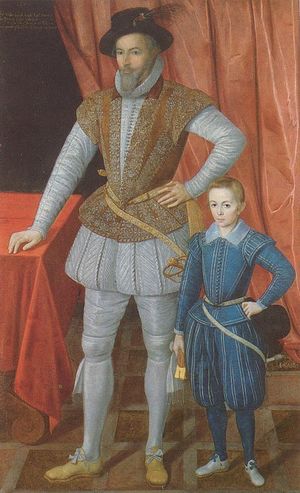Elizabethan clothing: Difference between revisions
Paul Matisz (talk | contribs) m (Reverted edits by Latindahcgyh@WEIAYHRCI.hotmail.co.uk (Talk); changed back to last version by Ladyadele) |
|||
| (46 intermediate revisions by 29 users not shown) | |||
| Line 1: | Line 1: | ||
[[image:WalterRaleighandson.jpg|thumb|right]] |
|||
'''Elizabethan clothing''' refers to the distinctive clothing during the reign of [[Elizabeth I]]. |
'''Elizabethan clothing''' refers to the distinctive clothing during the reign of [[Elizabeth I]]. |
||
| ⚫ | |||
| ⚫ | |||
| ⚫ | |||
| ⚫ | Most ordinary people wore clothes similar to those of the rich and fashionable people but they were simpler and made from materials like [[wool]] or [[linen]]. Children were usually dressed in smaller versions of their parents' clothes, although a portrait of Sir Walter Raleigh with his son shows Raleigh wearing a [[ruff]], while his son wears the wide collar that was to become popular after the death of Elizabeth. |
||
| ⚫ | |||
| ⚫ | Rich Elizabethan women wore a lot of clothes each day. Next to the skin went a linen smock or [[chemise]]. Over this went a [[pair of bodies|corset]] and a [[skirt]] or [[petticoat]]. The skirt was held up by [[hoop]]s and/or [[padding|padded]] at the hips. A dress went over this and on top of that there could be a loose gown. |
||
| ⚫ | |||
| ⚫ | |||
| ⚫ | |||
| ⚫ | |||
| ⚫ | |||
| ⚫ | |||
| ⚫ | |||
| ⚫ | |||
| ⚫ | |||
== See also:== |
|||
* http://costume.dm.net/ |
|||
* http://www.extremecostuming.com |
|||
[[category:clothing]] |
|||
Each ruff could contain up to 3,000 pins and it is said that when young ladies were dancing with young men at balls they were afraid to sneeze incase the pins shot out and stabbed the young man. It could take up to 3 hours making a ruff. |
|||
| ⚫ | |||
had wide ruffs so the spoon maker had to make a runcble spoon |
|||
Latest revision as of 01:43, 12 November 2010
Elizabethan clothing refers to the distinctive clothing during the reign of Elizabeth I.
Elizabeth loved jewelled clothes and left over 2,000 decorated dresses hanging in her wardrobe when she died.
Most ordinary people wore clothes similar to those of the rich and fashionable people but they were simpler and made from materials like wool or linen. Children were usually dressed in smaller versions of their parents' clothes, although a portrait of Sir Walter Raleigh with his son shows Raleigh wearing a ruff, while his son wears the wide collar that was to become popular after the death of Elizabeth.
Rich Elizabethan women wore a lot of clothes each day. Next to the skin went a linen smock or chemise. Over this went a corset and a skirt or petticoat. The skirt was held up by hoops and/or padded at the hips. A dress went over this and on top of that there could be a loose gown.
Rich men wore a linen shirt and drawers next to the skin. Over this went a and a tight-fitting jacket called a doublet. They wore stockings and padded breeches instead of trousers. Most wore a velvet or fur hat.
The Ruff
The most distinctive element of Elizabethan clothing is the ruff. Ruffs were worn around the neck or wrists and generally became larger later in the Elizabethan era.
See also:
Each ruff could contain up to 3,000 pins and it is said that when young ladies were dancing with young men at balls they were afraid to sneeze incase the pins shot out and stabbed the young man. It could take up to 3 hours making a ruff.
